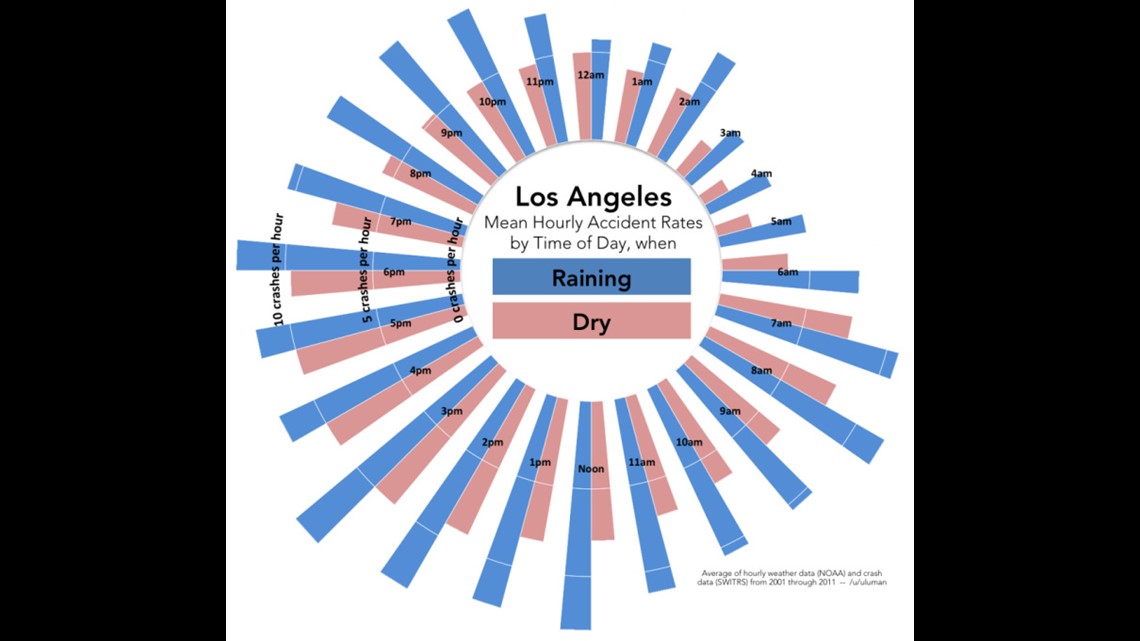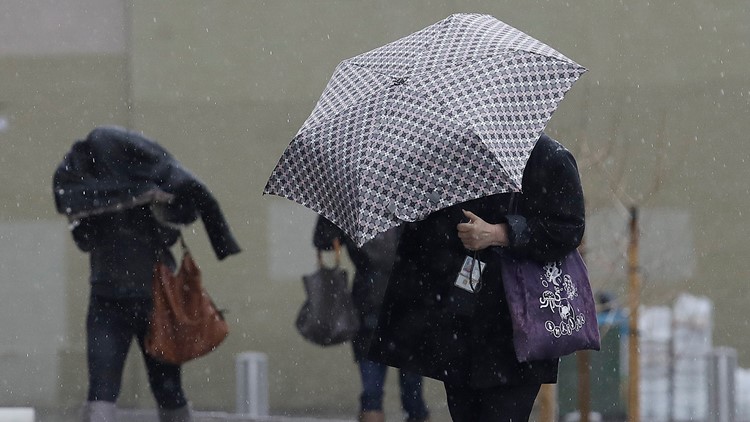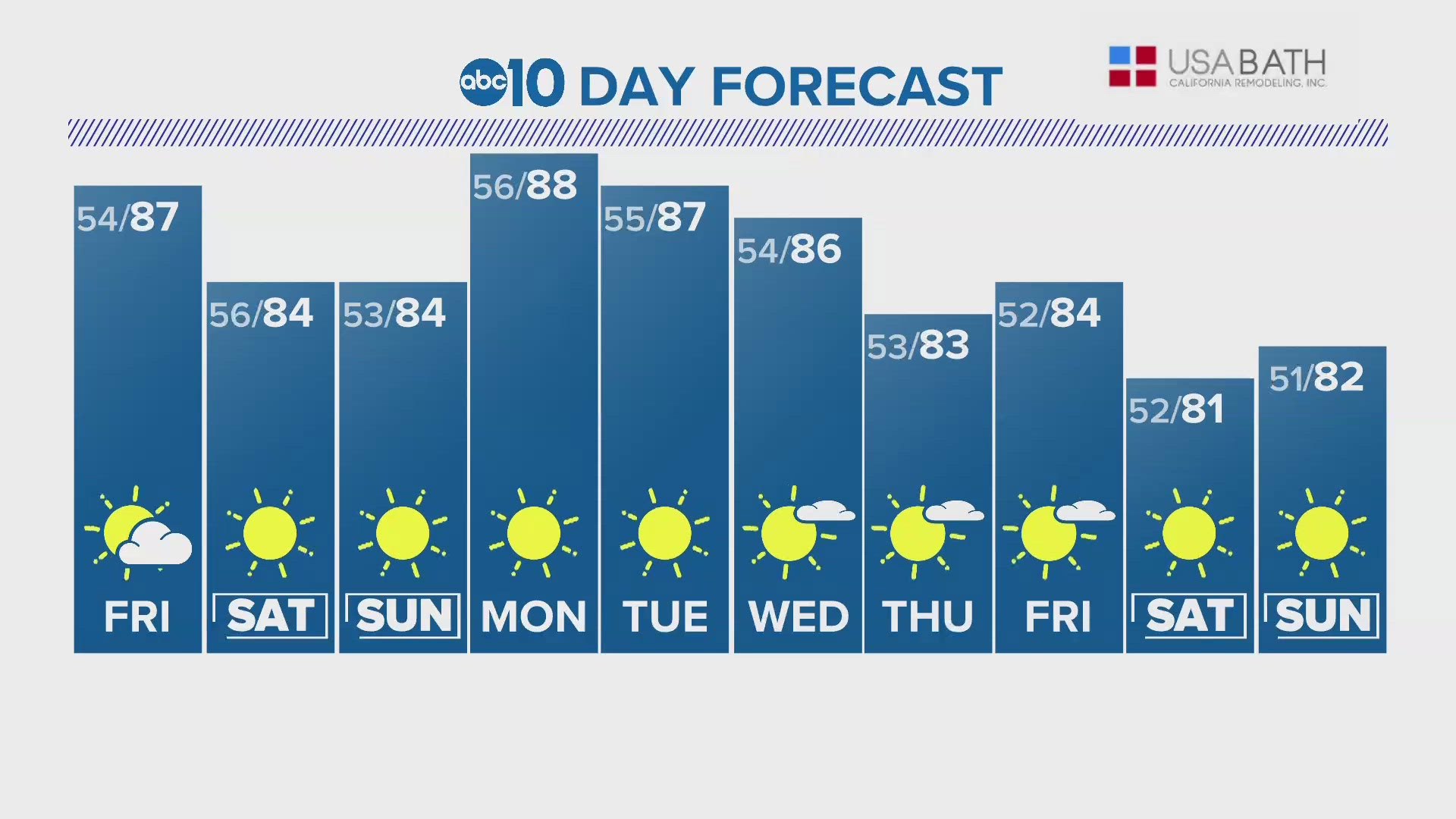California drivers are notoriously bad at driving in the rain. The typically sunny skies and mild weather of California can be a problem when it comes to operating a vehicle: When the rain comes, panic ensues.
The data seems to prove the truth of this stereotype. Noah Deneau, an electrical and computer engineer, compiled weather data from the National Oceanic and Atmospheric Administration (NOAA) to show just how impactful rain is on Los Angeles traffic accidents.


The infographic shows that at any time of the day, rainy weather causes more accidents than dry weather. At certain times of the day, the mean hourly accident rate nearly doubled.
However, this problem isn’t unique to Californians, despite what some non-locals may say about California drivers (we’re looking at you, East Coast natives!). According to a study which looks at weather-related traffic accidents from 1995 to 2005, poor driving in rainy weather conditions is a national problem. Nearly one-quarter of all weather-related vehicle crashes in the United States occurred in adverse road weather conditions. Seventy-five percent of those crashes happened when the pavement was wet and 47 percent happened during rainfall.
The study also found that states in the West, including California, have a lower percentage of weather-related crashes than any other region in the U.S. Based on the data from this study alone, drivers in the Midwest are far more likely to be in a weather-related accident than drivers in the West. Take that, haters!
Of course, whether or not California drivers are the worst in the U.S. at driving in the rain, it is always best to stay safe. Since weather forecasts are calling for on and off rains Wednesday and a chance of showers later in the week, here are some tips that everyone can use to stay safe:
Slow down! This is the easiest and one of the most effective tips on the list. Reducing your speed can not only help you react to things more quickly and help you brake faster, but it will help prevent hydroplaning and skidding on wet pavement. The California Department of Motor Vehicles recommends 5 to 10 miles per hours slower than the speed at which you would normally go.
Turn on your lights. For those who do not have automatic lights, this one may be easy to forget. However, just turning on your low beams can drastically increase visibility. DO NOT use high beams in rain or fog, as the light can reflect and make it more difficult to see.
Keep a greater distance between you and the car in front of you. With wind, rain, and the spray of water, mud, snow, and rocks from the car in front of you, keeping a good distance when driving can help you avoid accidents and will increase your visibility.
Use your windshield wipers. Is anyone else ever self-conscious about how fast your windshield wipers are moving? Well, don’t be. Using your windshield wipers is extremely important for visibility. Set them to a speed that you are comfortable with and which lets you see clearly. Double check that your windshield wipers don't need to be replaced!
Check the tread of your vehicle’s tires. The U.S. Department of Transportation recommends replacing tires when they reach 2/32”, and California legally requires tires to be replaced at this depth. To check tire depth, try the penny test. Place a penny between the tread ribs on your tire. Turn the penny so that Lincoln’s head points down into the tread. If the top of his head disappears between the ribs, your tread is still above 2/32. If you can see his entire head, it may be time to replace the tire.
Treat broken traffic lights like stop signs. This is a rule that not many drivers seem to know. If you are stopped at a traffic light that is blinking, you should treat it like a stop sign. This means that not only should you come to a full stop for two seconds or more, but you should watch out for other vehicles who might not know the law. Keep an eye out for people making left turns!
Know what to do if your car hydroplanes/aquaplanes! Calmly take your foot off the accelerator. Steer in the direction you want to go once you regain traction. Avoid making sudden turns or slamming on your brakes as this can cause you to spin out. Apply brakes gently once you feel your tires reconnect with the pavement.
Don’t tailgate, no matter how much they deserve it. Since visibility is low, it can be difficult to see and react quickly to the car in front of you breaking suddenly.
Watch out for standing water. Driving through standing water can cause your car to hydroplane (also known as aquaplane). Vehicles coming in the other direction can create bow waves which will drown your engine. The best advice is to avoid driving through standing water, but if you absolutely must, take it slowly and dry the brakes after you emerge from the water by using them gently.
Use the defroster. You may find that your vehicle’s windows become foggy when you operate your vehicles while it is raining. Most cars’ ventilation systems include a function that will work to reduce this type of fog that develops on the interior of your windows and windshield. It may be necessary to pull over if you are no longer able to see through your windows.
Maintain a firm hand position on the steering wheel. Two hands, always. Strong wind gusts and slippery roads are unpredictable. If you are not holding the wheel properly it can be jerked straight out of your hands.
WATCH MORE:
On the American River, veterans gather yearly to fish and talk with each other about life, and how they're handling the after-effects of their service.



